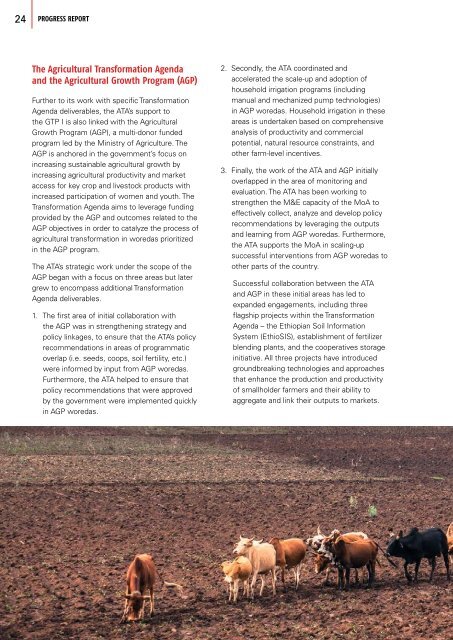PROGRESS REPORT
1LLMfQ4
1LLMfQ4
Create successful ePaper yourself
Turn your PDF publications into a flip-book with our unique Google optimized e-Paper software.
24 <strong>PROGRESS</strong> <strong>REPORT</strong> GTP I TRANSFORMATION AGENDA 25<br />
The Agricultural Transformation Agenda<br />
and the Agricultural Growth Program (AGP)<br />
Further to its work with specific Transformation<br />
Agenda deliverables, the ATA’s support to<br />
the GTP I is also linked with the Agricultural<br />
Growth Program (AGP), a multi-donor funded<br />
program led by the Ministry of Agriculture. The<br />
AGP is anchored in the government’s focus on<br />
increasing sustainable agricultural growth by<br />
increasing agricultural productivity and market<br />
access for key crop and livestock products with<br />
increased participation of women and youth. The<br />
Transformation Agenda aims to leverage funding<br />
provided by the AGP and outcomes related to the<br />
AGP objectives in order to catalyze the process of<br />
agricultural transformation in woredas prioritized<br />
in the AGP program.<br />
The ATA’s strategic work under the scope of the<br />
AGP began with a focus on three areas but later<br />
grew to encompass additional Transformation<br />
Agenda deliverables.<br />
1. The first area of initial collaboration with<br />
the AGP was in strengthening strategy and<br />
policy linkages, to ensure that the ATA’s policy<br />
recommendations in areasof programmatic<br />
overlap (i.e. seeds, coops, soil fertility, etc.)<br />
were informed by input from AGP woredas.<br />
Furthermore, the ATA helped to ensure that<br />
policy recommendations that were approved<br />
by the government were implemented quickly<br />
in AGP woredas.<br />
2. Secondly, the ATA coordinated and<br />
accelerated the scale-up and adoptionof<br />
household irrigation programs (including<br />
manual and mechanized pump technologies)<br />
in AGP woredas. Household irrigation in these<br />
areas is undertaken based on comprehensive<br />
analysis of productivity and commercial<br />
potential, natural resource constraints, and<br />
other farm-level incentives.<br />
3. Finally, the work of the ATA and AGP initially<br />
overlapped in the area of monitoring and<br />
evaluation. The ATA has been working to<br />
strengthen the M&E capacity of the MoA to<br />
effectively collect, analyze and develop policy<br />
recommendations by leveraging the outputs<br />
and learning from AGP woredas. Furthermore,<br />
the ATA supports the MoA in scaling-up<br />
successful interventions from AGP woredas to<br />
other parts of the country.<br />
Successful collaboration between the ATA<br />
and AGP in these initial areas has led to<br />
expanded engagements, including three<br />
flagship projects within the Transformation<br />
Agenda – the Ethiopian Soil Information<br />
System (EthioSIS), establishment of fertilizer<br />
blending plants, and the cooperatives storage<br />
initiative. All three projects have introduced<br />
groundbreaking technologies and approaches<br />
that enhance the production and productivity<br />
of smallholder farmers and their ability to<br />
aggregate and link their outputs to markets.<br />
Engagements with the AGP have also ledto<br />
a close working relationship with various<br />
development partners providing support to the<br />
overall program. In particular, some important<br />
linkages have been created between<br />
Transformation Agenda deliverables and USAID’s<br />
Feed the Future program.<br />
During GTP I, the primary area of engagement<br />
with Feed the Future has been with the<br />
Agricultural Growth Program–Agribusiness and<br />
Market Development (AGP-AMDe) program.<br />
This program aims to sustainably reduce poverty<br />
and hunger by improving the productivity and<br />
competitiveness of value chains that offer jobs<br />
and income opportunities for rural households. In<br />
addition, Feed the Future investments through a<br />
Fixed Amount Reimbursable Agreement (FARA)<br />
program have provided important contributions<br />
to deliverables in program areas such as Seeds,<br />
Cooperatives, Research, Input/Output Markets,<br />
Mechanization and Special Projects.<br />
Finally, as livestock became an area of work in<br />
the Transformation Agenda during the final year<br />
of GTP I, areas of collaboration were identified<br />
with the Agricultural Growth Program–Livestock<br />
Market Development program. Expanded<br />
partnerships between the AGP, Feed the Future<br />
and other relevant programs are expected to<br />
play a major role in the implementation of the<br />
Transformation Agenda during GTP II.


